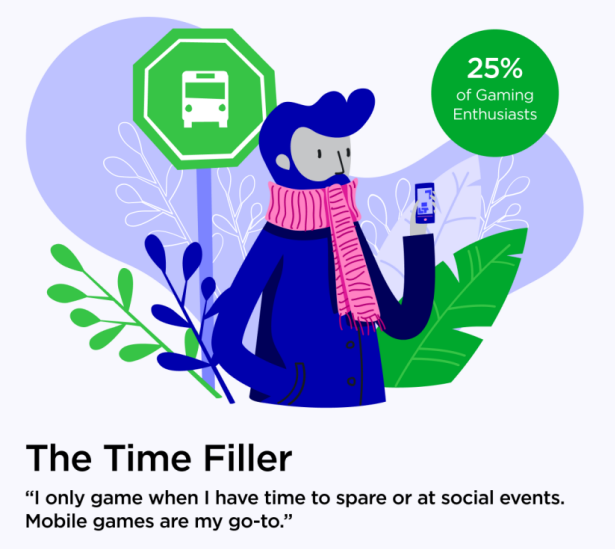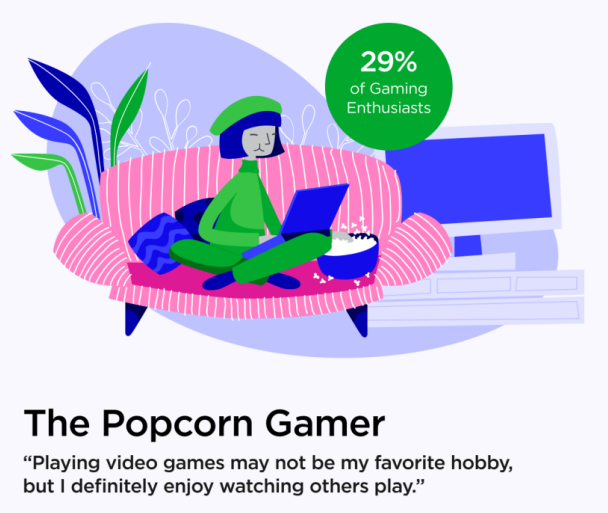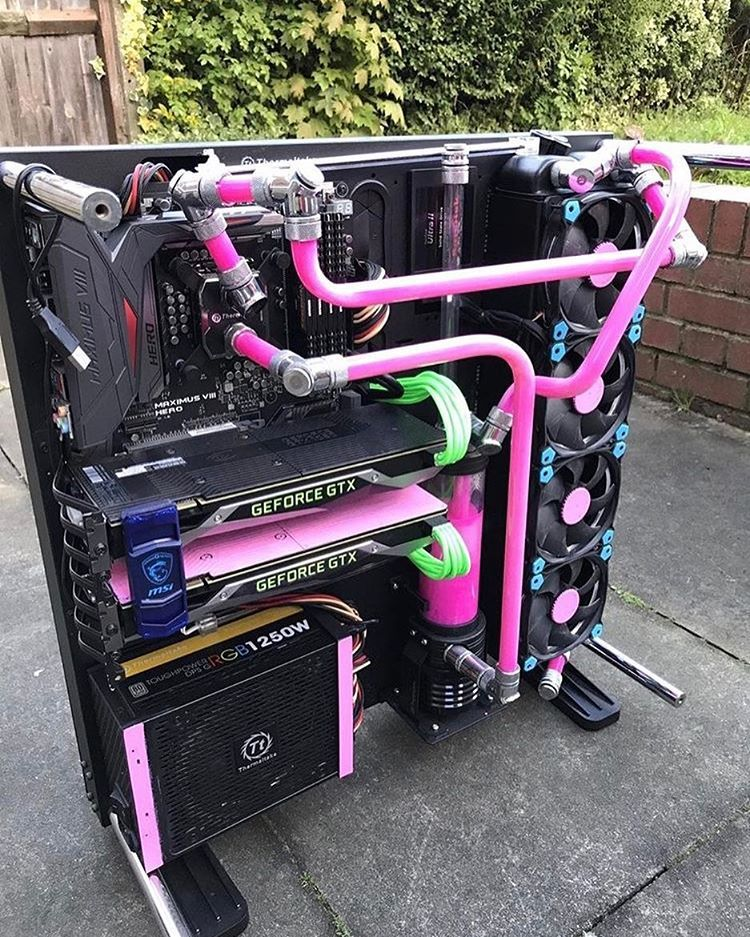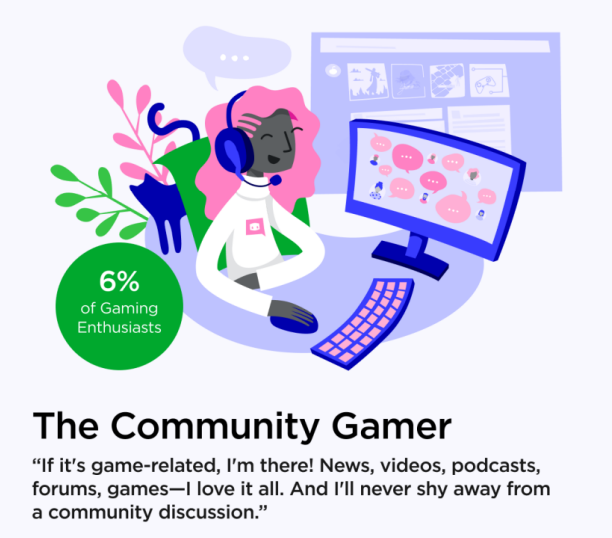For many years, the segmentation of types of gamers stood between “hardcore” and “casuals.” The first one is the ones that lived the “past golden age” of gaming with their very hands and eyes. Meanwhile, casual gamers were the ones that had fun once in a while, or they just played a few popular titles, most of them related to platformers and sports.
Enter the smartphone, and this previous classification blurs a bit. With gaming gaining new players yearly on every platform, companies wanted to understand their user base better. The craving for advanced analytics has swept across multiple industries, and stakeholders desperately needed new and better ways to understand their target audience.
With this context in mind, we can start talking about “Gamer Personas.” The Newzoo Gamer Segmentation Report clarified this concept about the different types of gaming personas around the industry. It highlights the core habits and characteristics of each kind of gamer, such as where they usually play, what they are like, and what value they place on playing and consuming various gaming content.
Without further ado, let’s dive directly into these types of gamer personas.
Gamer Segmentation by Personality
There are nine different gamer archetypes (although you will see two of them together as they share many of the same characteristics). The reason people need to know how to differentiate these gamer personas is all about marketing. Nothing is more important for marketing than knowing your target audience, and Newzoo’s report helps with that issue.
Because not everyone plays games the same way, companies need to identify which gaming audiences they should target. Let’s check the different types of gamer personas.
Ultimate Gamers

This is the “hardcore gamer” who wants to play, watch and own everything related to video games. They watch content related to gaming regularly and are familiar with everything that is going on in the industry and the Esports scene. They also want to own the greatest hardware and peripherals, and many of them have the means to do so.
They are usually between 26 and 30 years old, and most play games to “explore worlds and new storylines.” The home scenario is evenly split between living alone or with kids. Meanwhile, in the gender tab, the ultimate gamers are mostly males, with a 60-40% split between males and females. It is opposed to what the general gaming audience has become, almost even, with 52% males and 48% females.
When new consoles launch or a new piece of high-level hardware is on sale, the ultimate gamer will be the early adopter. They enjoy watching streaming content regularly, and some will play Esports games competitively. For these reasons, ultimate gamers consume content over Twitter and other news media to always stay at the top of the action. To summarize, this is the new “hardcore gamer.”
All-Around Enthusiasts

They are similar to the ultimate gamers but with less fanaticism for pursuing the hobby. Yet, they are very serious about gaming, and most have full-time jobs that allow them to buy hardware and purchase the games they want.
This gamer persona tends to be older than the ultimate gamer (rounding most of them 29 years old). Their main reason for playing games is to “escape from everyday life” and “to fill time.” Their home scenario is similar to the previous category, and the gender split is even wider than the ultimate gamers, with 64% being males against 36% females.
Time-Fillers

The time-filler gamers are the largest group on the list. The massive increase in the global market of mobile devices led to also increase in the offer of mobile gaming, aiming for the casual gamer, which is most of the people with this type of gaming persona.
It is largely built around mobile experiences. These people usually don’t care about watching gaming content or owning hardware. They only play games when they have downtime, when commuting, or at social events where some game is being played.
Most of them are around 38 years old, but there also is a large amount of 51-65 years old individuals on the list. It fits with the phenomenon of older people starting to play games. Of course, the main reason to play games for this group is to fill time, and it will be the first group on this list to have more females than males, with 60% against 40%. This group is likely to have kids and usually play the same games as them.
Backseat Viewers

This gamer persona doesn’t play games, at least not at the moment. They used to play, but life got in the way, and other tasks and commitments disrupted their ability or financial capabilities to do so. Some of them will still watch major gaming events and play from time to time, but they aren’t going to buy hardware or just pick up offers from game stores.
Most of them have kids in their homes, and some portion of the content they consume is the lead of whatever their children are playing and watching. They are close even regarding gender, with 56% being males against 44% females.
Popcorn Gamers

They don’t play games very often but constantly watch gaming content and esports online. They would watch them alone or with friends and also consume lots of television and online videos. When they do play a game, it’s usually on a mobile platform and in a casual way.
Most of them are above 31 years old and play video games to fill their time. Compared with the rest of the list, it is a group that is less likely to have kids at home. When talking about gender, it is almost equal, with 51% in favor of males against 49% of females.
This group is driving the big growth of streaming content and online videos, both gaming-related and not-gaming stuff. It is a big target audience for gaming companies as they expect that watching certain games on Twitch or YouTube will influence them to play it as one of the few gaming experiences. It is a large group compared with the rest of the list, and they tend to play very few games, so the competition to make them play their game is fierce between companies.
Hardware Enthusiasts

They want the best possible hardware that is on the market, no matter what type of game they are playing. Their interests extend beyond gaming. Yet, they will stay updated on news and trends in service of their hardware obsession.
They mainly play games to fill time, and they average 32 years old, with a heavy lean on having kids at home. Most of them are male, with 59% against 41% of females.
They are interested in PC building, showing impressive cases with RGB lights and water-cooled desktop equipment. They are willing to spend money on whatever is needed to get the latest pieces of technology and graphic cards. They will likely have a VR headset to go along with their high-level gear. For VR games, this group would be an interesting target audience to aim for.
Lapsed Gamers

A lapsed gamer is the “old guard hardcore gamer” from a decade ago. For them, gaming was more of an insular hobby, as gaming content in the forms of videos and streaming wasn’t a thing back then, and esports tournaments weren’t already taken off in a large way. They don’t care much about content, but they still try to stay up to date with the latest news in the industry. They will purchase the necessary hardware to keep playing their favorite games.
This type of gamer persona average is around 32 years old. Most of them play games to escape everyday life and have a 59/41% split between males and females.
Subscribers (Bargain Buyers and Community Gamers)

It is a type that is taking its form in recent years. Also known as “Cloud Gamers,” they don’t know much about hardware, and they don’t bother, but at the same time, they are passionate about gaming. The only time they buy hardware is when it is completely necessary for a gaming experience (a new console or a VR headset) or when they receive it as a gift.
The average age of this persona is under 30 years old, and their main reason is mixed between filling time and escaping everyday life. They are also mixed in the home scenario of being alone, with a couple, or with kids. While on the gender tab, it is 57% in favor of males against 43% of females.
They are the ones that would adopt cloud services (like Microsoft’s xCloud) and subscription services (like Xbox Game Pass and PS Plus). It allows them to play on hardware they already have, or at least it is affordable for them. It enables you to jump around different games, so it is also a good platform for social gamers that want to be part of online communities or be together with their friends for a more chill experience. It is expected this group will grow with time.
Closing Thoughts
The different types of gamer personas give a better perspective and understanding of what each gamer is like as a person, their strong points, and their difficulties. It also better depicts the “gamer” as a whole.
With most of these groups having a family and children rather than any other familiar setting, it is clear those kids who grew up gaming will keep with the hobby as they age, becoming a renewed demographic.
It also gives an additional perspective on women. It shows them as they are almost the same amount as “gamer men” and “gamer women,” and in the “ultimate gamer” category, they come in around 40% of the group. Gaming’s no longer a “men’s thing.”
Lastly, it gives everyone working in the industry the tools to understand their target audiences better and refine their marketing strategies to fit all those involved. At the end of the day, it will become a win for all.

SEO enthusiast and digital marketing strategist. My expertise lies in optimizing websites for organic traffic growth and search engine visibility. I carry out, among others, SEO tests, keyword research and analytical activities using Google Analytics. Privately, he is a lover of mountains and bicycle trips.

